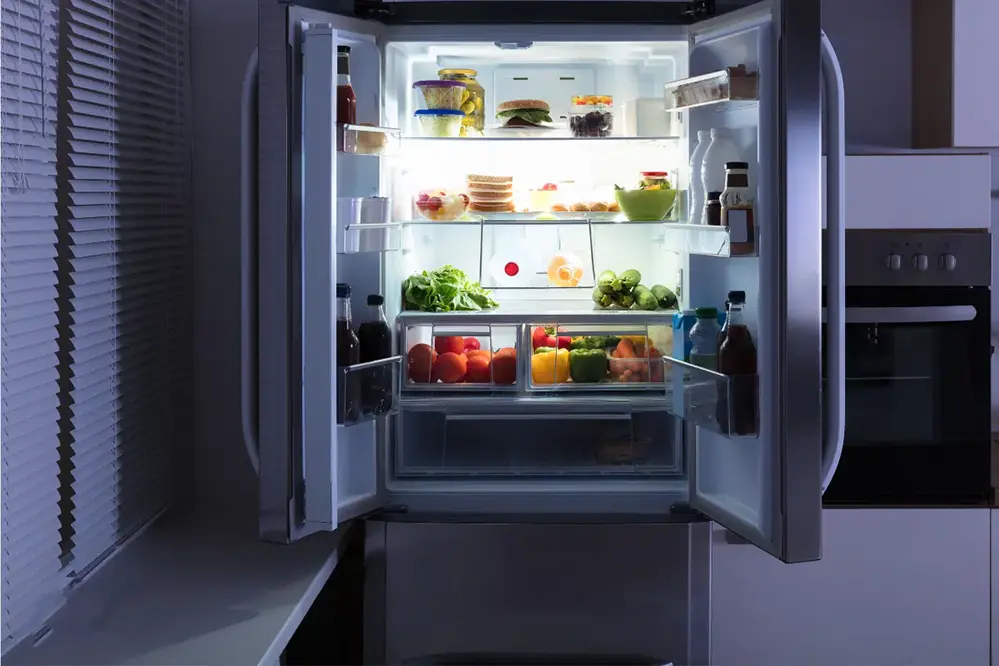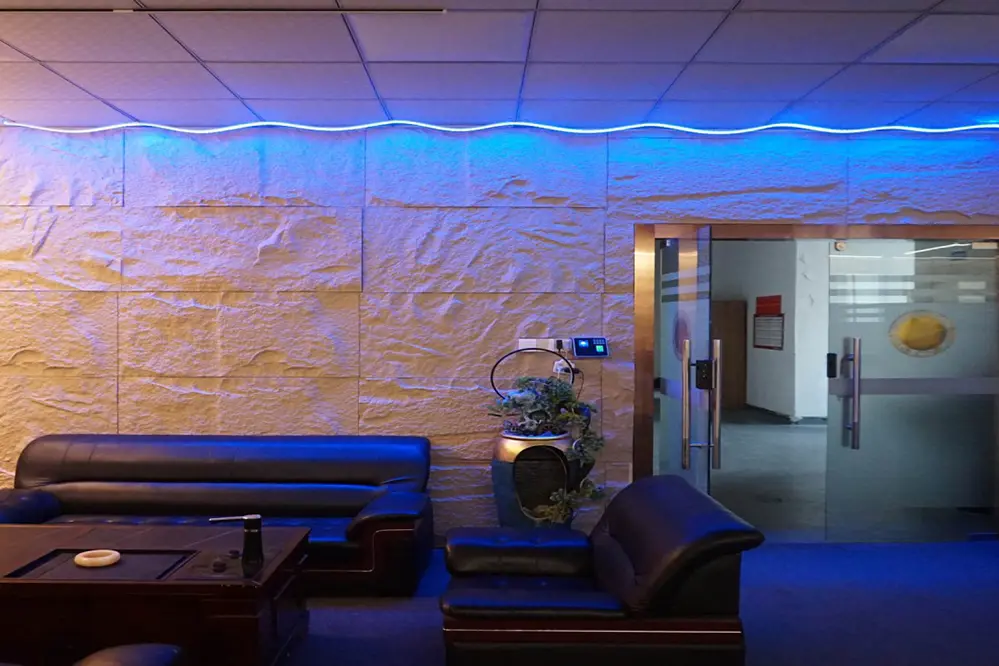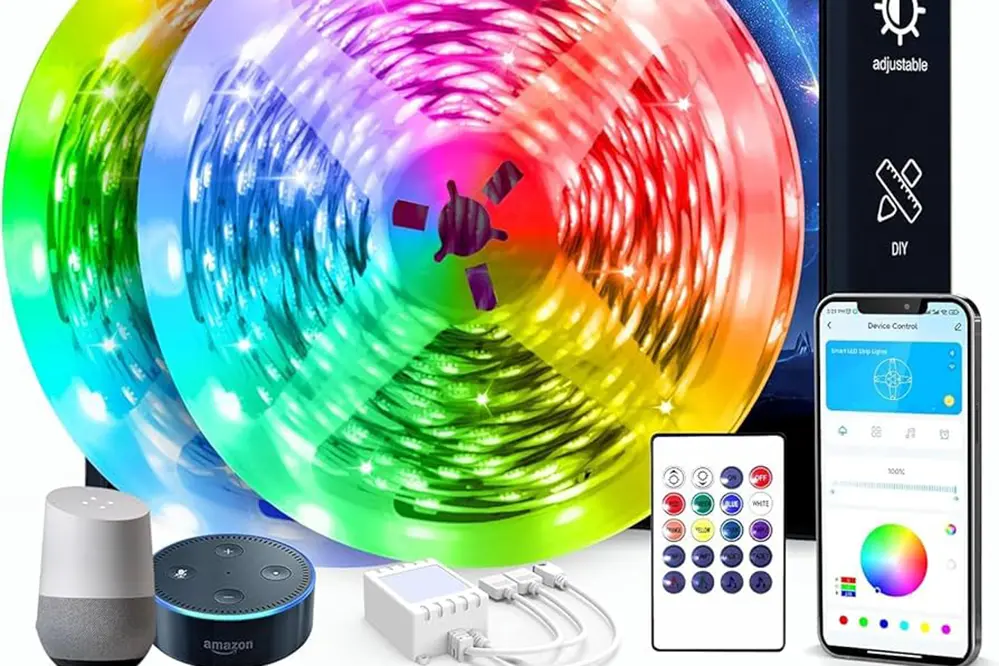If you’re considering upgrading your fridge lighting to LED bulbs, you’re making a smart choice. With extensive knowledge on energy-efficient solutions, we can guide you through the benefits and practicalities of using LED bulbs in your refrigerator.
LED bulbs can be used in refrigerators as they are energy-efficient, durable, and perform well in cold temperatures, making them an excellent choice for fridge lighting.
Want to know why LED bulbs are the best choice for your fridge? Continue reading to explore their advantages, installation tips, and how they compare to traditional lighting options.
Understanding LED Bulbs for Appliances
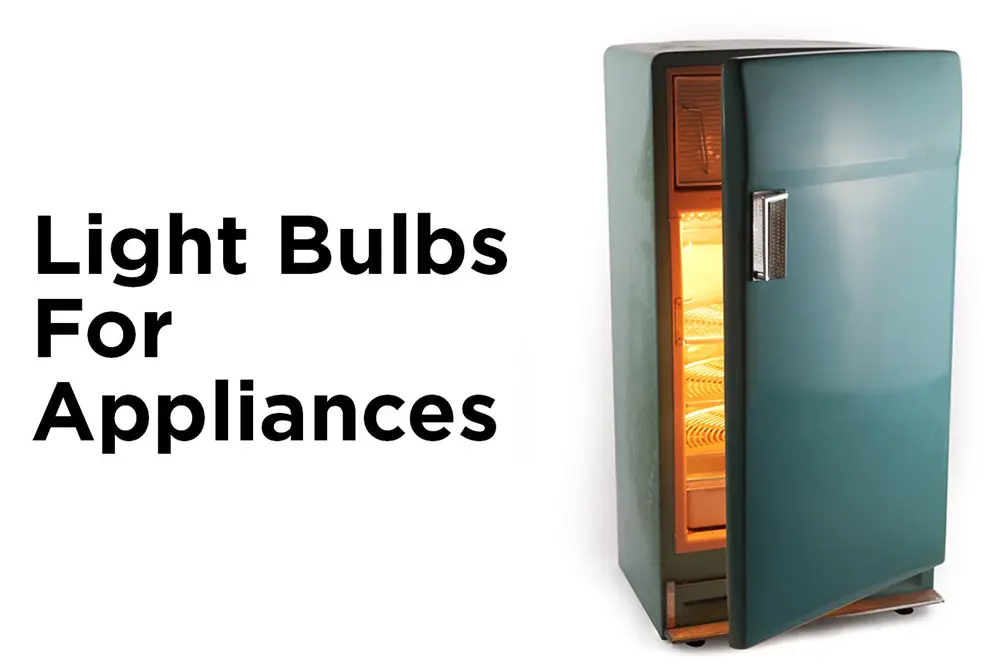
Immersed in the growing realm of technology, LED bulbs offer a refreshing take on appliance lighting, including within refrigerators.
LED bulbs, or light-emitting diodes, are a culminating achievement in lighting technology. They promise reduced energy consumption, extended longevity, and superior lighting quality, making them an ideal choice for use in various household appliances. Unlike traditional incandescent bulbs, LEDs deliver impeccable performance while embracing an eco-friendly footprint, encouraging a future-oriented approach to how we experience everyday conveniences.
Furthermore, their ability to function in cooler environments adds another layer of suitability for refrigerator use. Unlike other bulb types, which may falter or produce unpredictable results, LED bulbs maintain consistent performance throughout their lifespan, even amidst fluctuating temperatures typically found within appliance interiors.
In summary, the advantages extend beyond mere functionality. Choosing LEDs reflects a commitment to sustainability, efficiency, and innovation, as these remarkable bulbs align perfectly with contemporary environmental standards. Their robust construction ensures reliability and adaptability, positioning LED bulbs as quintessential components in the advancing landscape of appliances. Such advancements undeniably pave the way for more intelligent, eco-conscious choices within the comforts of our homes.
Advantages of Using LED Bulbs in Refrigerators
LED bulbs are a masterstroke of modern lighting technology, bringing immense benefits when used in refrigerators.
Primarily, LEDs significantly reduce energy consumption, benefiting both the environment and your wallet. Their efficiency comes from using less electricity to produce the same, if not greater, brightness compared to conventional bulbs.
Moreover, the longevity of my LED bulbs ensures their appeal. They dramatically outperform traditional incandescent bulbs in lifespan, reducing the frequency of replacements and contributing to less waste.
Their durability and resistance to the cold environment inside refrigerators mean LED bulbs maintain their lighting quality without compromise, a fact many consumers may not know. This consistent performance is pivotal in ensuring your refrigerator remains well-lit at all times.
Embrace the brilliance of LEDs put in your refrigerator for a sustainable, cost-effective lighting solution.
Energy Efficiency of LED Bulbs
LED bulbs represent a paradigm shift in energy-efficient technology, offering bright prospects for homeowners. Inside the refrigerator, they work wonders by consuming considerably less energy, ensuring your food stays visibly appealing without escalating your energy bills.
In comparison to their incandescent predecessors, LED bulbs operate with a minimalist ethos, soaking up a fraction of the power yet delivering uncompromised illumination. By minimizing electricity usage, LEDs support a greener lifestyle and enhance sustainability. Thus, the coalescence of energy-saving and illuminating brilliance makes LED bulbs an impeccable choice for a refrigerator’s lighting needs.
How LEDs Save Energy in Refrigerators
LEDs revolutionize how refrigerators consume energy, creating a synergy of technology and sustainability that transforms everyday appliances. Their low energy demand signifies substantial reductions in household energy consumption.
A marvel of modern engineering, LEDs produce less heat compared to traditional bulbs. This means refrigerators use less energy trying to offset heat generated by the bulb itself, resulting in efficient operation.
LED bulbs yield up to 80% more efficiency compared to traditional incandescent bulbs.
Thriving on a simplified and intelligent design, LED bulbs don’t merely contribute to energy-saving— they lead the charge. By diminishing heat emission and conserving power, LEDs are the subtle champions of energy efficiency. The integration of LED lighting into refrigerators epitomizes innovative living, providing pronounced savings and promoting environmental stewardship.
Longevity and Durability of LED Bulbs
LED bulbs exhibit remarkable longevity, making them an exceptional choice for refrigeration environments, where they can shine persistently, year after year.
Impressively, these hardy bulbs typically outlast incandescent options.
When considering their extended lifespan—often lasting decades—LEDs provide a level of durability that is key to a lifetime of reliable refrigeration without the constant need for replacement—enhancing efficiency, convenience, and sustainability for the conscientious consumer.
Moreover, the robust design integrity of LED bulbs enables them to withstand the rigorous conditions of a refrigerator much more effectively than traditional options. Whether exposed to frequent temperature changes or the occasional jostling by a carton of milk, these resilient light sources continue to perform optimally. In this way, LED bulbs serve as “guardians” of consistent illumination, unyielding in their mission to brighten your fridge.
Can You Use LED Bulbs in the Fridge?
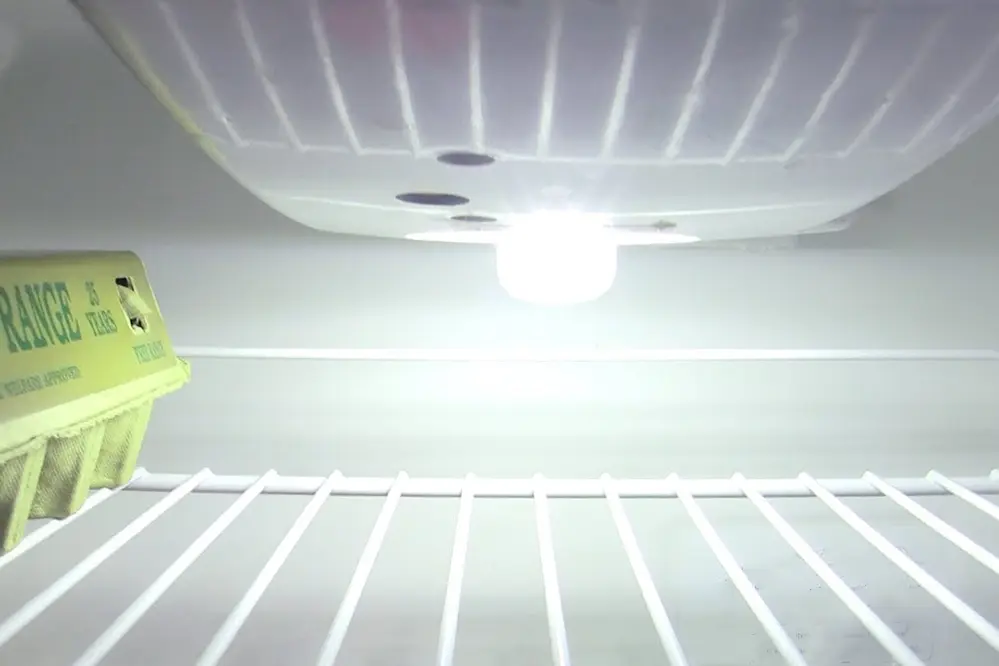
Embracing the modernization of lighting solutions, one might wonder if LED bulbs are suitable for fridge interiors. Indeed, the advent of LEDs brings an array of advantages over their traditional counterparts.
LED bulbs are not only energy-efficient but also maintain a brightness that revitalizes any refrigerator space.
Moreover, they produce significantly less heat, seamlessly integrating into cold environments without compromising fridge efficiency.
This thermal efficiency contributes to maintaining optimal temperatures inside the fridge, thus ensuring food preservation is uncompromised.
Furthermore, LED technology promises a remarkable reduction in energy consumption, allowing eco-conscious individuals to reduce their carbon footprint while enjoying sustained, quality illumination within their refrigerators.
Ultimately, the path is clear for those wishing to illuminate their fridge with LEDs’ confidence, welcoming a future where efficiency and reliability unite in every flickerless glow.
Comparing LED Bulbs to Traditional Bulbs
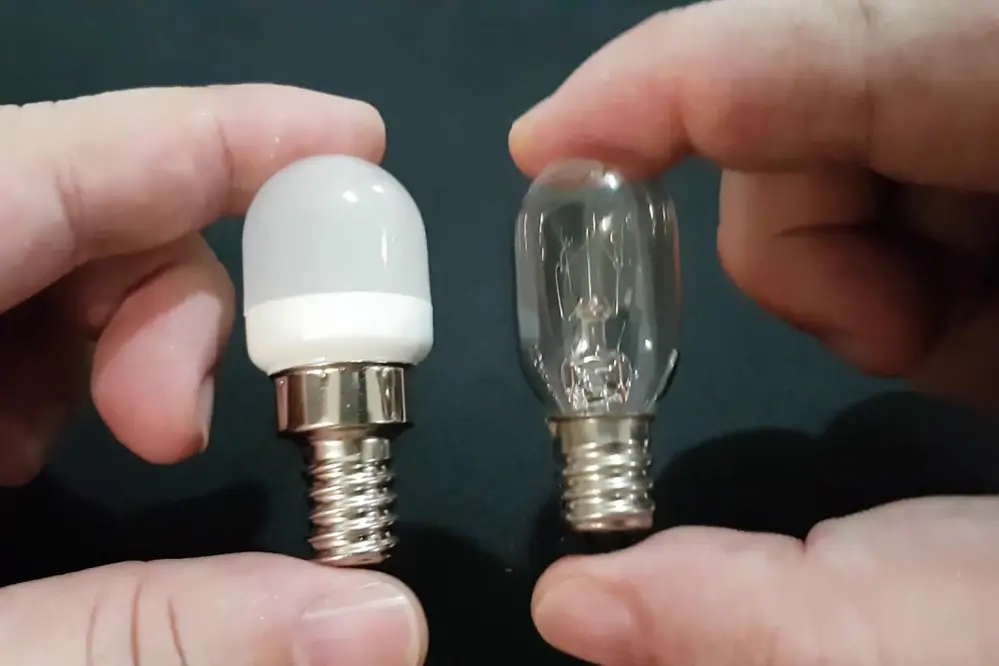
In comparing LED bulbs to traditional incandescent or compact fluorescent bulbs, a myriad of transformational benefits come to light. LEDs, for instance, emit a consistent brightness that enhances visibility, an essential trait for refrigerator interiors. Furthermore, their durability often surpasses that of traditional options, reducing replacement frequency and associated maintenance hassles. By providing this enduring illumination, LEDs ensure that every corner of your fridge is bathed in a steady light, unfailingly ready to showcase your fresh produce and chilled items, thus marrying function with sustainability in a way traditional bulbs struggle to achieve.
LED vs. Incandescent Bulbs in Refrigerators
The savvy choice to retrofit LED bulbs instead of incandescent bulbs in refrigerators leads to enhanced efficiency and practicality.
- Energy Efficiency: LED bulbs consume significantly less energy, resulting in lower utility costs and reduced environmental impact.
- Durability: LEDs have a longer lifespan, often outlasting incandescent bulbs, diminishing the need for frequent replacements.
- Brightness: Offering consistent, vibrant illumination, LEDs improve visibility within the refrigerator, enhancing convenience.
- Heat Emission: LEDs emit minimal heat, ensuring refrigerator temperatures remain stable, contributing to the preservation of stored foods.
Selecting LEDs over incandescent bulbs revitalizes my refrigeration experience with sustainability.
Embrace the future with LEDs, and witness the harmony of cost-saving and superior performance.
Safety Considerations for LED Bulbs
When contemplating whether you can use LED bulbs in the fridge, rest assured, LED bulbs are designed for low-voltage, damp locations common in refrigerators. They are built to withstand cooler environments, thus ensuring reliability and safety. Furthermore, LEDs significantly reduce fire hazards as they generate much less heat compared to traditional incandescent bulbs. This feature alone offers peace of mind knowing your refrigerator interior remains safe while operating-efficiently.
Moreover, the environmentally benign nature of LEDs translates into a reduction of harmful substances, such as mercury, often found in other bulbs. This means you not only enhance your appliance’s performance but also contribute positively to a safer planet.
LED Bulb Temperature Compatibility
LED bulbs thrive in diverse environments.
Their design enables them to endure cooler spaces. From the intricate structure of the bulb to the external coatings, every element is crafted to meet the demanding requirements of various temperature settings. Consequently, they excel in maintaining robust functionality and efficiency, even when faced with the cold climates typical of a refrigerator.
Incandescents often falter under icy conditions.
By contrast, LEDs continue to illuminate brilliantly – an essential trait as consistency ensures long-term reliability without compromising efficiency or safety. In achieving this, LEDs preserve energy and extend lifespan, allowing them to surpass other lighting options.
With relentless innovation driving LED advancements, they now boast exemplary temperature resilience, proving indispensable in this chilled context. The latest year has seen significant progress, rendering LED bulbs an irreplaceable component in the orchestration of modern, efficient refrigerated environments. This evolution exemplifies how a commitment to progress escorts us towards a brighter, sustainable tomorrow.
Cost Effectiveness of LED Bulbs
In the realm of energy savings, LED bulbs stand out, offering economical advantages well beyond their purchase and installation costs.
LEDs, by design, are masters of energy efficiency, which translates into substantial savings over time, particularly in environments where they are used extensively. Since they consume far less energy compared to traditional incandescent bulbs, they dramatically reduce electricity bills, contributing positively to the household budget and, on a larger scale, to the national energy economy. This cost reduction is a compelling reason many individuals and businesses are turning towards LED solutions.
Moreover, LEDs boast an impressive longevity, often lasting several times longer than traditional bulbs. This extended lifespan not only means fewer replacements but also less maintenance, both of which significantly lower the overall costs associated with lighting over years of use.
When evaluating the fiscal prudence of embracing LED technology, the return on investment becomes clear. By integrating LED bulbs into refrigerators and other appliances, one taps into energy-efficient lighting solutions that promise lower energy consumption rates. This commitment to efficient lighting serves not only the individual consumer with cost savings but also supports sustainable practices that benefit the global community.
Installation Tips for LED Refrigerator Bulbs
Switching to LED refrigerator bulbs is simple.
First, ensure that you put your fridge into the off position by unplugging it to avoid any risk of electrical shock. Once you’ve confirmed that your appliance is safely disconnected from the power source, open the refrigerator and locate the existing bulb. Carefully unscrew or unlatch it, paying attention to how it is installed for an effortless replacement.
The new LED bulb’s installation is straightforward.
Gently insert the LED bulb into the socket, turning clockwise to secure it – make sure not to overtighten, as this might damage the fixture. It’s equally important to check the compatibility of the bulb with your refrigerator model to prevent any mishaps.
Ultimately, this small upgrade can make a world of difference, enhancing your kitchen’s efficiency and aesthetics. As LED technology advances, newer bulb models emerge that are designed to withstand cold environments, ensuring that your refrigerator remains both stylish and energy-efficient. Embrace this change with confidence, knowing you’ve made a robust improvement to your home.
Common Myths About LED Bulbs
Despite the advancements in LED technology, several myths persist, which may cause hesitation in adopting these energy-efficient wonders. Let’s dispel these misconceptions and illuminate the truth about LED bulbs.
A prevalent myth is that LED bulbs don’t emit enough light. This couldn’t be further from the truth.
Indeed, LED bulbs are designed to provide ample brightness, rivalling their incandescent counterparts and offering impressive longevity.
Another common myth suggests LEDs are prohibitively expensive, ignoring how they decrease energy bills with extended lifespans.
Some fear LEDs contain hazardous materials like mercury, a myth stemming from comparisons with older bulb types. LED bulbs, however, are free from mercury, offering an environmentally friendly lighting solution.
Finally, set aside any assumptions that LEDs can’t handle cold temperatures. Modern LED bulbs are exceptionally well-suited to environments like refrigerators, shining brightly with remarkable efficiency.
Troubleshooting LED Bulb Issues
If your LED bulb isn’t illuminating as expected, check the bulb’s compatibility with your refrigerator, ensuring it meets the appliance’s specifications.
Sometimes, all you need is a gentle adjustment to fit.
Ensure the bulb is securely fastened and makes proper electrical contact. Always verify compatibility by consulting the refrigerator’s manual, as some models require specific bulb types.
Should you notice flickering or intermittent operation, it may be due to a loose connection or an unsuitable product. In such instances, inspect the socket for damage or corrosion, and consider obtaining a bulb explicitly recommended for your appliance. Remember, persistence and a dose of patience often pave the path to a well-lit fridge.
Environmental Impact of LED Bulbs
LED bulbs stand as pioneers in environmentally friendly lighting, offering solutions that greatly minimize our ecological footprint.
In a world striving for sustainable practices, LEDs present a remarkable opportunity to cut energy consumption, slashing the energy use by up to 80% compared to incandescent bulbs. This efficiency radiates far beyond individual households, substantially reducing greenhouse gas emissions from power plants. By choosing LEDs, one contributes to a meaningful decrease in the infamous global carbon footprint.
Additionally, the longevity of LED bulbs is a game-changer for environmental conservation. Lasting up to 25 times longer than traditional lighting options, LEDs significantly reduce waste. The less frequent replacement not only conserves resources but also lessens the burden on landfills.
Furthermore, by eschewing hazardous materials like mercury, found in some conventional lighting, LEDs embrace a cleaner production process. This means safer disposal methods, less hazardous waste management, and an overall healthier ecosystem. Embracing the brilliance of LED technology, we illuminate a brighter and more sustainable path for our planet, proving that modern innovation and environmental stewardship can harmoniously coexist.
Final Thoughts on Using LED Bulbs in Refrigerators
LED bulbs are an excellent choice for refrigerator lighting, offering both energy efficiency and durability. Their ability to perform consistently in cold temperatures makes them perfectly suited for the unique demands of fridge environments. This choice not only enhances lighting quality but also contributes to significant energy savings.
Beyond their practical benefits, LEDs represent a commitment to environmental stewardship. By opting for these bulbs, you’re making a conscious decision to support sustainability. Their extended longevity means fewer replacements, reducing waste and promoting a greener lifestyle.
Embracing LED technology in your refrigerator is a step towards a future-ready home. This transition underscores a commitment to modernization and ecological consciousness, ensuring that each choice for LED lighting contributes to a more sustainable future for both households and the planet.
